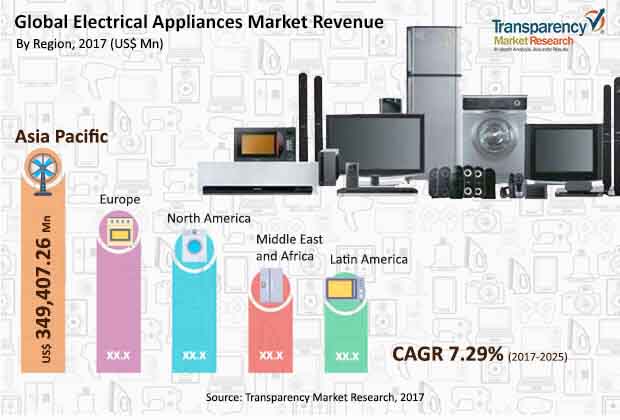
The global electrical appliances market was valued at around US$ 685 Bn in 2016 and is anticipated to register a CAGR of ~7% from 2017 to 2025, according to a new report by Transparency Market Research (TMR) titled “Electrical Appliances Market- Global Industry Analysis, Size, Share, Growth, Trends, and Forecast, 2017–2025.”
Electrical appliances are defined as devices which use electricity to perform specific functions. A wide range of such appliances is available from refrigerators, wine-coolers, washing machines, tumble dryers, vacuum cleaners, steam mops, shavers, trimmers and water heaters to air conditioners, air coolers, heaters, fans, rice cookers, bread makers, toasters, irons, and juicers. A wide range of companies across the world manufacture and sell such appliances, providing customers with a large range of options. The global electrical appliances market is expected to register a medium rate of growth during the forecast period. However, this growth rate will be spread unevenly across the different regions of the world. The developing region of Asia Pacific is especially expected to witness a higher growth rate, followed by North America, whereas Europe is expected to witness slower growth rate during the same period.

Higher standards of living and availability of lucrative product offers and purchase credit schemes to drive the market for electrical appliances
One of the primary drivers of the market is higher standards of living, especially in the Asia Pacific region. As the average monthly income of households has increased, they have been able to make purchases beyond their basic human necessities. This has led households to purchase electrical appliances, which have historically been looked upon as luxury items. Another major factor driving the global electrical appliances market are the lucrative offers and the easy availability of credit schemes to purchase them. In fact, the purchase decision of nearly 70% of potential customers is positively influenced by such offers.
For More Industry Insight, Request Sample@ https://www.transparencymarketresearch.com/sample/sample.php?flag=S&rep_id=41387
The major restraint on the global electrical appliances market is the consistent and considerable R&D investment required to develop new, more efficient, environment-friendly, smart, and connected appliances. It is a highly competitive market coupled with increasingly stringent government regulations regarding emissions of environmentally harmful chemicals. In such a scenario, the constant improvement of products is important, though this is mostly possible only by the larger companies such as Whirlpool Corporation, Haier Group, and LG Electronics Inc.
Product differentiation and new product development are expected to be among the available opportunities in the global electrical appliance market during the forecast period
Major opportunities in the global electrical appliances market exist in product differentiation and new product development. Almost all the companies focus on providing a wide range of products to meet the needs and price affordability of consumers from different economic strata. This in turn creates the need for product differentiation. Companies try to provide this through the different features offered in the appliances. For example, a 1-door refrigerator is more affordable for consumers belonging to the lower end of the economic strata whereas the high-cost side-by-side refrigerators are offered to consumers from the higher end of the economic strata. Similarly, the top-loading washing machines are targeted toward consumers from the lower end of the economic strata, whereas the front-loading washing machines are targeted at the consumers from the higher end of the economic strata.
In terms of new product development, the forecast period is expected to witness the rise of smart and connected electrical appliances. These appliances go a long way in easing the work of households by giving them the ability to remotely control and operate the products through mobile phone applications. Appliance manufacturing companies are aiming to gain a foothold in this segment through either acquisitions or in-house development of relevant technology.





